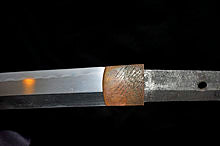Your Cart is Empty


Did you know that polishing is one of the most time-consuming processes associated with producing traditional Japanese swords? After the swordsmith has forged the blade, he or she gives it to someone who specializes in polishing. Known as a togishi, this person's sole job is to polish and improve the aesthetics of the sword.
It's not uncommon for the togishi to spend several weeks polishing a Japanese sword, which is longer the actual crafting of the blade. Nonetheless, polishing plays an instrumental role in creating attractive, high-quality swords. When a Japanese sword is polished correctly, it will shine with beauty. On the other hand, poorly polished swords can suffer from both aesthetic and structural flaws, which subsequently lowers its selling value.
Normally, traditional Japanese swords are polished in two stages: shitaji togi and shiage togi. To learn more about these stages of polishing and how they are performed, keep reading.
Shitaji togi
During the first stage, the togishi inspects the sword to ensure it's straight. If there's any unnatural warping, the togishi must correct it. This is typically done by using wooden jigs to correct the bend. After the blade has been straightened, the togishi will grind the blade's surface to achieve a smooth texture.
If the sword contains fullers (grooves), the togishi will also polish them. Instead of using large stones, however, he or she will use smaller stones. Modern practices of Japanese sword polishing also involve the use of burnishings needles as well as fine-grit sandpaper for this purpose. In feudal Japan, the togishi would simply use small stones to polish a sword's fullers during this stage.
Shiage togi
The second stage of sword polishing is shiage togi. During this stage, the togishi works to create a mirror-like finish on the blade by using even smaller polishing stones than used previously in the first stage.
Another fundamental difference between the shitaji togi and shiage togi stages is that the former involves moving the blade while the latter involves keeping the blade stationary. Instead of moving the blade, the togishi moves the stones and tools over the blade during shiage togi. It's a tedious and oftentimes painstaking process that involves carefully polishing every square inch of the blade.
After the togishi is finished, he or she adds a special compound known as nugui to balance the blade's appearance and texture. Once complete, the blade is ready to be used or sold.